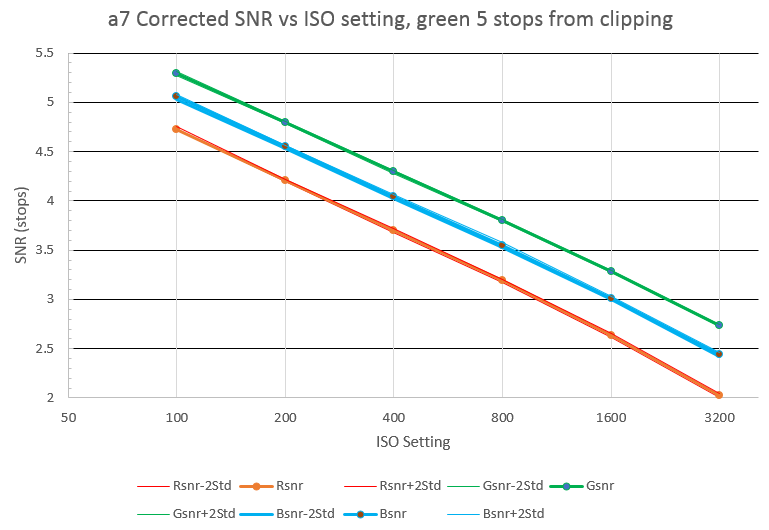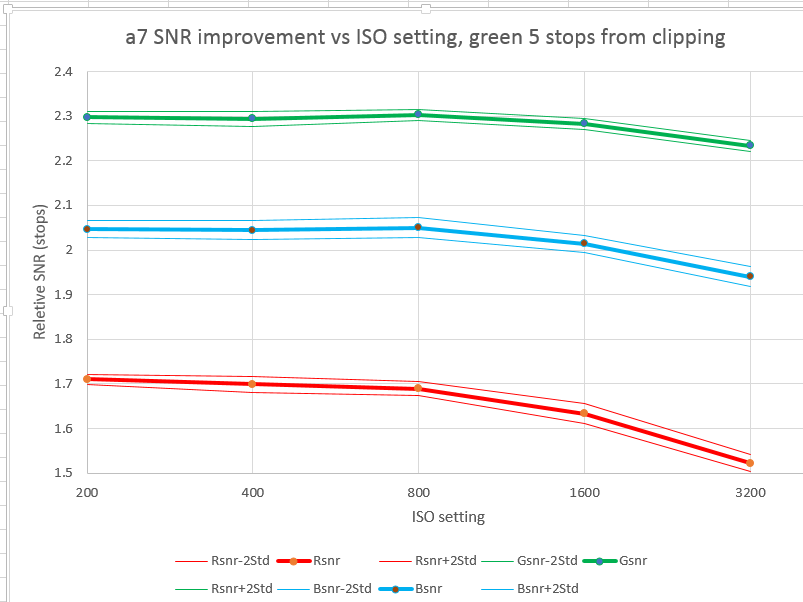With the noise floor and self-heating testing out of the way, we’re ready to tackle the question, “Is the a7 ISOless?” If that question makes no sense to you, hang in there. Explanations follow. If you’ve read this or a similar explanation before, skip to the graphs.
Let’s talk a bit about how your camera works. First, there are the photosites, or sensels, which are little features (usually one per pixel of the demosaiced image) on the sensor that collect photons and produce electrons. Those electrons create a voltage that can be measured by an analog-to-digital converter (ADC), and thus the output of the ADC is more-or-less proportional (with today’s sensors, it’s almost perfectly proportional) to the number of photons collected by the photosite. There’s an amplifier between the sensels and the ADC whose gain is controlled by the ISO setting on the back of the camera. Higher ISO means more gain.
That’s fine up to a point. With a perfect ADC and no other noise associated with reading the data out of the photosite, it doesn’t improve the signal-to-noise ratio (SNR) to crank up the gain of that amplifier past the point where one photon captured results in one least-significant-bit (LSB) change in the ADC output. If you’re a digital photography maven, you call this gain the Unity Gain. This terminology is a big step away from the way we engineers usually use the word “gain”, and it makes me cringe, but it’s the language of the art, and I will explain it here. To an engineer, gain is almost always dimensionless: volts out over volts in, or milliamps out divided by milliamps in. This Unity Gain manages to be dimensionless only if we call the units of the input counts (number of photons) and the unit of the output counts (steps in the ADC output). Unity gain occurs when one photon creates one step.
If we step away from the ideal world, it doesn’t help the signal to noise ratio to increase the gain over that which results in a two or three LSB change. That often occurs at depressingly low ISOs, and there’s a way to test your camera to see what it is. Even better, there’s a test I’ve developed to figure out when turning up the ISO stops helping you increase the SNR that doesn’t require directly measuring the Unity Gain point.
I set up the camera aimed at a white card, and defocussed the lens. The light source was a Paul Buff Einstein studio flash unit, so that I am able to precisely control the light level and make series at various sensor averages. There’s no PC receptacle on the a7, so I used a hot shoe to PC converter. I tried to use the great-in theory-but-so-far-maddening in practice Cyber Commander to trigger the flash, but I couldn’t make it work. The lens was the Leica 135mm f/3.4 APO; the range from f/4 to f/22 is enough to encompass the ISO range from 200 to 3200). I set the camera to ISO 3200, the shutter to 1/200, adjusted the brightness of the strobe so that the green channel of the raw file was about five stops down from full scale. I made 16 exposures. Then I turned the ISO down to half of what it was, opened up a stop, and make another 16 exposures. I continued until I got to ISO 100.
As I said, I make 16 exposures for each data point, averaging the results from those exposures. As a side benefit of that approach, I can compute the standard deviation of the underlying single-exposure data for each data point, and plot that information on the graphs to give an idea of the possible sampling errors involved.
I brought one of the images into RawDigger, selected a square in the middle that’s 200 pixels on a side, measured the mean and standard deviation of all four sets of pixels. I left the selection where it was, and measured the same statistics for all the rest of the images. For each image, I computed the SNR; the mean is the signal, the standard deviation is the noise.
I normalized all of the data so that they were corrected for the actual exposure of the test images, as measured by the mean value of the pixels in the selection box. This calibrates out exposure variations caused by inaccuracies in the shutter and the aperture, gain of the amplifiers in the camera, and variations in strobe brightness caused by power line variation and recycling interval.
I plotted the data, with the log (base 2) of the SNRs as the vertical axis, and the log (base 2) of the film speed as the horizontal axis.
The data I collected gives red counts of about 180, blue counts of about 400, and green counts of about 300. The mean, mean-plus-two-standard-deviations, and mean-minus-two-standard-deviations lines are plotted below. If the data is Gaussian, for a large sample, less than five percent of the results lie outside of the two lighter lines. You’ll note that the two-sigma lines lie almost right on top of the mean ones. This is remarkable consistency:
Here’s what the a7 data looks like if we subtract out the half-stop-per-stop effect of having fewer photons as the ISO setting goes up:
You can see that, in spite of my earlier suspicions, you don’t gain anything in shadow SNR by turning up the ISO past the base value of 100, and indeed, if you go too far up on the ISO dial, you’re hurting yourself. If the position of the ISO control has no effect on the SNR after Exposure corrections have been made in your favorite raw converter, some people say that that camera is ISO-less. That is the case with the a7.


n/a says
> Here’s what the a7R data looks
that was a typo ? a7, not a7R
Jim says
Fixed now. Thanks.
n/a says
and in your experience you do not think that any intermediate/”low” ISOs have to be tested w/ Sony sensor in Sony body for any unexpected results like may be w/ some other combos ?